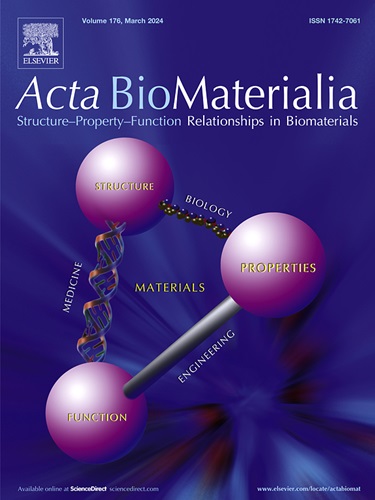Incorporation of metal-doped silicate microparticles into collagen scaffolds combines chemical and architectural cues for endochondral bone healing
IF 9.4
1区 医学
Q1 ENGINEERING, BIOMEDICAL
引用次数: 0
Abstract
Regeneration of large bone defects remains a clinical challenge until today. While existing biomaterials are predominantly addressing bone healing via direct, intramembranous ossification (IO), bone tissue formation via a cartilage phase, so-called endochondral ossification (EO) has been shown to be a promising alternative strategy. However, pure biomaterial approaches for EO induction are sparse and the knowledge how material components can have bioactive contribution to the required cartilage formation is limited. Here, we combined a previously developed purely architecture-driven biomaterial approach with the release of therapeutic metal ions from tailored silicate microparticles. The delivery platform was free of calcium phosphates (CaP) that are known to support IO but not EO and was employed for the release of lithium (Li), magnesium (Mg), strontium (Sr) or zinc (Zn) ions. We identified an ion-specific cellular response in which certain metal ions strongly enhanced cell recruitment into the material and showed superior chondrogenesis and deposition collagen II by human mesenchymal stromal cells (MSCs). At the same time, in some cases microparticle incorporation altered the mechanical properties of the biomaterial with consequences for cell-induced biomaterial contraction and scaffold wall deformation. Collectively, the results suggest that the incorporation of metal-doped silicate microparticles has the potential to further improve the bioactivity of architectured biomaterials for bone defect healing via EO.
Statement of significance
Endochondral bone healing, a process that resembles embryonic skeletal development, has gained prominence in regenerative medicine. However, most therapeutic biomaterial strategies are not optimized for endochondral bone healing but instead target direct bone formation through IO. Here, we report on a novel approach to accelerate biomaterial-guided endochondral bone healing by combining cell-guiding collagen scaffolds with therapeutic metal-doped silicate microparticles. While other strategies, such as hypoxia-mimic drugs and iron-chelating biomaterials, have been documented in the literature before to enhance EO, our approach uniquely implements enhanced bioactivity into a previously developed biomaterial strategy for bone defect regeneration. Enhanced cell recruitment into the material and more pronounced chondrogenesis were observed for specific hybrid scaffold formulations, suggesting a high relevance of this new biomaterial for improved endochondral bone healing.

将金属掺杂硅酸盐微颗粒掺入胶原蛋白支架中,结合化学和建筑线索,促进软骨内骨愈合。
直到今天,大面积骨缺损的再生仍然是一项临床挑战。虽然现有的生物材料主要通过直接的膜内骨化(IO)来解决骨愈合问题,但通过软骨阶段(即所谓的软骨内骨化(EO))形成骨组织已被证明是一种很有前景的替代策略。然而,用于诱导 EO 的纯生物材料方法并不多见,人们对材料成分如何对所需的软骨形成具有生物活性的了解也很有限。在这里,我们将之前开发的纯结构驱动生物材料方法与从定制硅酸盐微粒中释放治疗性金属离子相结合。该递送平台不含已知支持 IO 但不支持 EO 的磷酸钙 (CaP),并用于释放锂 (Li)、镁 (Mg)、锶 (Sr) 或锌 (Zn) 离子。我们发现了一种离子特异性细胞反应,其中某些金属离子能强烈促进细胞进入材料,并显示出人类间充质基质细胞(MSCs)具有卓越的软骨生成和胶原蛋白 II 沉积能力。同时,在某些情况下,微颗粒的加入改变了生物材料的机械性能,对细胞诱导的生物材料收缩和支架壁变形产生了影响。总之,研究结果表明,掺金属硅酸盐微颗粒的加入有可能进一步提高架构生物材料的生物活性,从而通过环氧乙烷促进骨缺损愈合。意义说明:软骨内骨愈合是一种类似于胚胎骨骼发育的过程,在再生医学中已占据重要地位。然而,大多数生物材料治疗策略并未针对软骨内骨愈合进行优化,而是通过膜内骨化直接形成骨。在此,我们报告了一种新方法,通过将细胞引导胶原支架与治疗性掺金属硅酸盐微颗粒相结合,加速生物材料引导的软骨内骨愈合。虽然之前已有文献记载了其他策略(如缺氧模拟药物和铁螯合生物材料)来增强软骨内骨化,但我们的方法将增强生物活性独特地应用到了之前开发的骨缺损再生生物材料策略中。在特定的混合支架配方中,观察到细胞进入材料的能力增强,软骨生成更加明显,这表明这种新型生物材料对改善软骨内骨愈合具有重要意义。
本文章由计算机程序翻译,如有差异,请以英文原文为准。
求助全文
约1分钟内获得全文
求助全文
来源期刊

Acta Biomaterialia
工程技术-材料科学:生物材料
CiteScore
16.80
自引率
3.10%
发文量
776
审稿时长
30 days
期刊介绍:
Acta Biomaterialia is a monthly peer-reviewed scientific journal published by Elsevier. The journal was established in January 2005. The editor-in-chief is W.R. Wagner (University of Pittsburgh). The journal covers research in biomaterials science, including the interrelationship of biomaterial structure and function from macroscale to nanoscale. Topical coverage includes biomedical and biocompatible materials.
 求助内容:
求助内容: 应助结果提醒方式:
应助结果提醒方式:


